
 HARVEST HOUSE PUBLISHERS EUGENE , OREGON Cover by John Hamilton Design Cover illustration Sandy Silverthorne The Very Best One-Minute Mysteries and Brain Teasers Copyright 2007, 2010 Sandy Silverthorne and John Warner Published by Harvest House Publishers Eugene, Oregon 97408 www.harvesthousepublishers.com ISBN 978-0-7369-7430-1 (pbk) ISBN 978-0-7369-7431-8 (eBook) Library of Congress Cataloging-in-Publication Data Names: Silverthorne, Sandy, 1951- author. | Warner, John., 1980- author. Title: The very best one-minute mysteries and brain teasers / Sandy Silverthorne and John Warner. Other titles: Very best one minute mysteries and brain teasers Description: Eugene, Oregon: Harvest House Publishers, [2018] Identifiers: LCCN 2018008267 (print) | LCCN 2018028087 (ebook) | ISBN 9780736974318 (ebook) | ISBN 9780736974301 (paperback) Subjects: LCSH: Puzzles. | Detective and mystery stories. | Brain teasers.
HARVEST HOUSE PUBLISHERS EUGENE , OREGON Cover by John Hamilton Design Cover illustration Sandy Silverthorne The Very Best One-Minute Mysteries and Brain Teasers Copyright 2007, 2010 Sandy Silverthorne and John Warner Published by Harvest House Publishers Eugene, Oregon 97408 www.harvesthousepublishers.com ISBN 978-0-7369-7430-1 (pbk) ISBN 978-0-7369-7431-8 (eBook) Library of Congress Cataloging-in-Publication Data Names: Silverthorne, Sandy, 1951- author. | Warner, John., 1980- author. Title: The very best one-minute mysteries and brain teasers / Sandy Silverthorne and John Warner. Other titles: Very best one minute mysteries and brain teasers Description: Eugene, Oregon: Harvest House Publishers, [2018] Identifiers: LCCN 2018008267 (print) | LCCN 2018028087 (ebook) | ISBN 9780736974318 (ebook) | ISBN 9780736974301 (paperback) Subjects: LCSH: Puzzles. | Detective and mystery stories. | Brain teasers.
Classification: LCC GV1493 (ebook) | LCC GV1493 .S587 2018 (print) | DDC 793.73dc23 LC record available at https://lccn.loc.gov/2018008267 All rights reserved. No part of this electronic publication may be reproduced, stored in a retrieval system, distributed, or transmitted in any form or by any meanselectronic, mechanical, digital, photocopy, recording, or any otherwithout the prior written permission of the publisher. The authorized purchaser has been granted a nontransferable, nonexclusive, and noncommercial right to access and view this electronic publication, and purchaser agrees to do so only in accordance with the terms of use under which it was purchased or transmitted. Participation in or encouragement of piracy of copyrighted materials in violation of authors and publishers rights is strictly prohibited. To my mom and dadthanks for all the encouragement and support. And to Kristen, Jaxon, Chloe, and Ella.
John To Vickimy wife, my love, and my best friend. You are truly a gift from the Lord. Its a fun adventure discovering lifes mysteries with you. To Christythank you for all the fun and laughter, and thanks for helping me stay immatureuh, childlike. Sandy Thanks to Kristin Warner for At the Bus Stop, Choosing Sides, The Long Way Home, The New Girl, and Teachers Pet. Thanks to Katie Trimble for Underpaid?  Contents What Are One-Minute Mysteries? These short interactive mysteries are usually played in a group as an interactive game.
Contents What Are One-Minute Mysteries? These short interactive mysteries are usually played in a group as an interactive game.
You might know them as lateral thinking puzzles, yes/no puzzles, or situation puzzles. Each puzzle describes an unusual scenario, and your job is to figure out what is going on. Although the puzzles may seem open-ended, the goal is to figure out the most satisfying answer, the one that suddenly appears when the lightbulb goes off in your head and you say, Aha! (In other words, youre looking for a solution that matches the one in the back of the book.) Each mystery takes less than a minute to read, and then you can take your time and enjoy the sleuthing process! How Do I Solve Them? These puzzles dont generally provide you with enough information to find the solution, but you can fill in the gaps by asking yes-or-no questions. The solving process is similar to the game of 20 questions, but instead of finding the identity of a thing, you solve a mystery. Youll need one other person in order to enjoy these puzzles to the fullest, and the more people, the better! Choose one person to be the case master. This person reads a puzzle aloud and privately consults the answer in the back of the book.
All other players are the detectives. They take turns posing questions to the case master, who can respond by saying yes or no or something like That doesnt matter or Rephrase your question. The case master provides clues from the back of the book as needed. The game is won when someone figures out the key to the solution. It isnt necessary to recite the entire solution, but only to figure out the part that explains what is puzzling. What Kind of Questions Should I Ask? Start by asking big-picture questions.
You will be tempted to jump right in and guess the answer, but you will most likely be wrong. In the game of 20 questions, you wouldnt start by guessing if the person is thinking of a tow truck. Instead, youd get some general information first. Use the same strategy here. Give yourself something to build on by asking questions like these: Is the location important? Is anyone else involved? Could this happen to me? As you figure out what is going on, you can ask more specific questions. Also, ask completely random and off-the-wall questions.
You never know what will spark some new insight! Here is a sample puzzle and some dialogue that shows how the questioning process works: C ASE M ASTER : Bob is a delivery man, and hes in a hurry. He approaches a railroad crossing as the barriers start lowering. He wont cross the intersection before they close, but he doesnt have time to stop. What does he do? D ETECTIVE : Does his speed matter? C ASE M ASTER : No. D ETECTIVE : Does he go a different way? C ASE M ASTER : No. D ETECTIVE : Does he drive over or under a bridge? C ASE M ASTER : No and no.
D ETECTIVE : Does the kind of vehicle Bob is driving matter? C ASE M ASTER : Yes! D ETECTIVE : Is the vehicle Bob is driving really short? C ASE M ASTER : It doesnt matter. D ETECTIVE : Okay, is Bob driving an ambulance and the train stops for Bob? C ASE M ASTER : No. D ETECTIVE : Umis Bob driving something that doesnt have to stop for the railroad crossing? C ASE M ASTER : Yes! D ETECTIVE : Oh! Is Bob actually driving the train himself? C ASE M ASTER : Yes! Bob is driving the train, so he continues through the crossing. D ETECTIVE : That was tricky. What Else Do I Need to Know? 1. Always check your assumptions.
If a puzzle doesnt come right out and say something, dont assume it is true. Ask yourself, What am I assuming? If the case master cant answer one of your questions with a yes or no but instead tells you to rephrase your question, you are probably assuming something that isnt true. 2. The five senses are often important in these puzzles. Ask questions about sight, sound, touch, taste, and smell. Dont forget to check the opposite of what you initially observe.
Should the person see, hear, smell, taste, or feel something he or she cant? 3. Ask yourself who, what, when, why, how, and where. Who is involved? What is important in the puzzle? When did this occur? Is the time of day or the year important? Why did things happen this way? Does it matter where this happened? How did it happen? 4. Eliminate red herrings. Look at each element of the puzzle and ask if it is important. 5. 5.
Ask if you are being tricked. Many times these puzzles arent as straightforward as they seem and are actually leading you to believe something that isnt true. 6. Think laterallythat is, think creatively or outside the box. If you have exhausted all the obvious possibilities and dont know where else to go, use your imagination and view the problem from a new perspective. Can I Solve Them by Myself? If you investigate these mysteries on your own, the clues section will serve as your guide.
Once you have read all the clues, your goal is to come up with a satisfying solution that fits all the constraints of the mystery and clues. This process is still fairly open-ended because you might come up with solutions that are different from the one in the back of the book. If you come up with a solution that is more satisfying than the one in the back of the book, congratulationsyou are clever indeed! If you have never solved lateral thinking puzzles before, try solving them with the help of someone else first so you can learn how they work. The last 20 puzzles in the book are more suited for doing alone. What About the Illustrations? This book contains two kinds of puzzles. Most of the puzzles include illustrations that show a humorous yet incorrect depiction of what is happening.
Next page
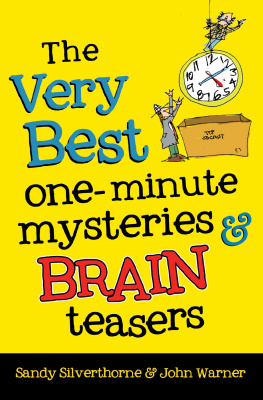
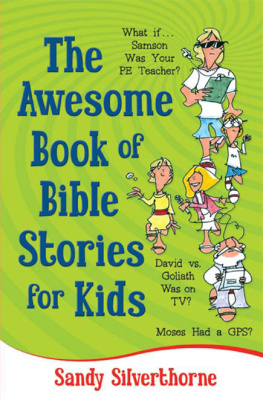

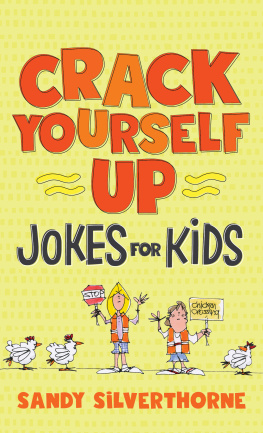

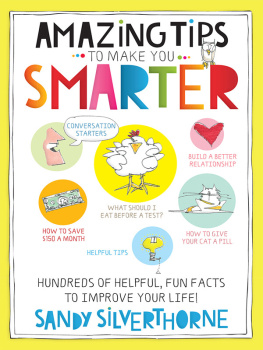
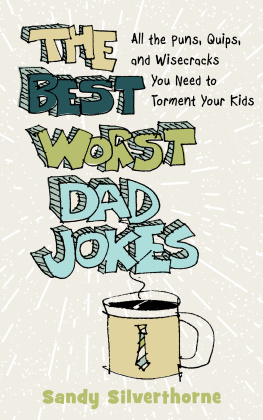
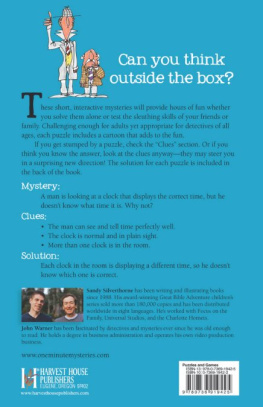
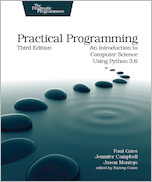

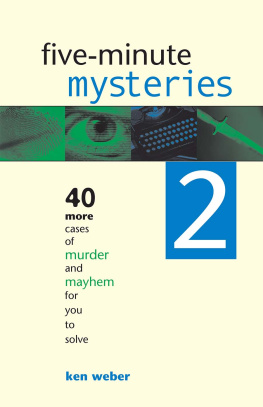
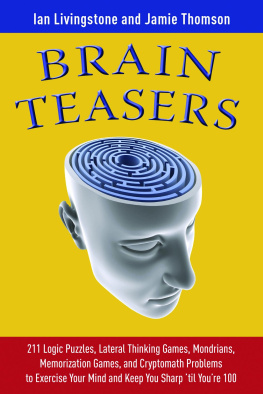

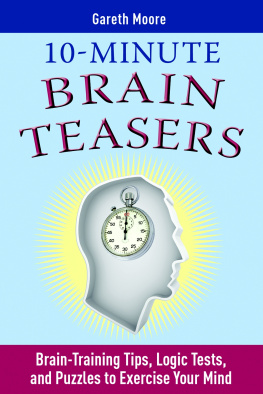
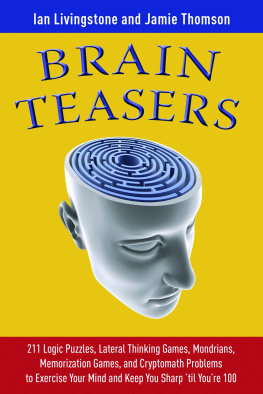
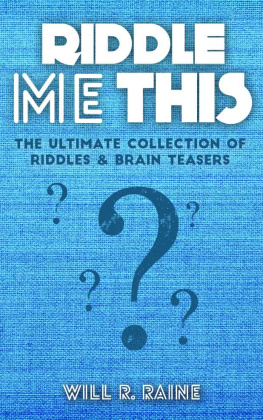

 HARVEST HOUSE PUBLISHERS EUGENE , OREGON Cover by John Hamilton Design Cover illustration Sandy Silverthorne The Very Best One-Minute Mysteries and Brain Teasers Copyright 2007, 2010 Sandy Silverthorne and John Warner Published by Harvest House Publishers Eugene, Oregon 97408 www.harvesthousepublishers.com ISBN 978-0-7369-7430-1 (pbk) ISBN 978-0-7369-7431-8 (eBook) Library of Congress Cataloging-in-Publication Data Names: Silverthorne, Sandy, 1951- author. | Warner, John., 1980- author. Title: The very best one-minute mysteries and brain teasers / Sandy Silverthorne and John Warner. Other titles: Very best one minute mysteries and brain teasers Description: Eugene, Oregon: Harvest House Publishers, [2018] Identifiers: LCCN 2018008267 (print) | LCCN 2018028087 (ebook) | ISBN 9780736974318 (ebook) | ISBN 9780736974301 (paperback) Subjects: LCSH: Puzzles. | Detective and mystery stories. | Brain teasers.
HARVEST HOUSE PUBLISHERS EUGENE , OREGON Cover by John Hamilton Design Cover illustration Sandy Silverthorne The Very Best One-Minute Mysteries and Brain Teasers Copyright 2007, 2010 Sandy Silverthorne and John Warner Published by Harvest House Publishers Eugene, Oregon 97408 www.harvesthousepublishers.com ISBN 978-0-7369-7430-1 (pbk) ISBN 978-0-7369-7431-8 (eBook) Library of Congress Cataloging-in-Publication Data Names: Silverthorne, Sandy, 1951- author. | Warner, John., 1980- author. Title: The very best one-minute mysteries and brain teasers / Sandy Silverthorne and John Warner. Other titles: Very best one minute mysteries and brain teasers Description: Eugene, Oregon: Harvest House Publishers, [2018] Identifiers: LCCN 2018008267 (print) | LCCN 2018028087 (ebook) | ISBN 9780736974318 (ebook) | ISBN 9780736974301 (paperback) Subjects: LCSH: Puzzles. | Detective and mystery stories. | Brain teasers. Contents What Are One-Minute Mysteries? These short interactive mysteries are usually played in a group as an interactive game.
Contents What Are One-Minute Mysteries? These short interactive mysteries are usually played in a group as an interactive game.